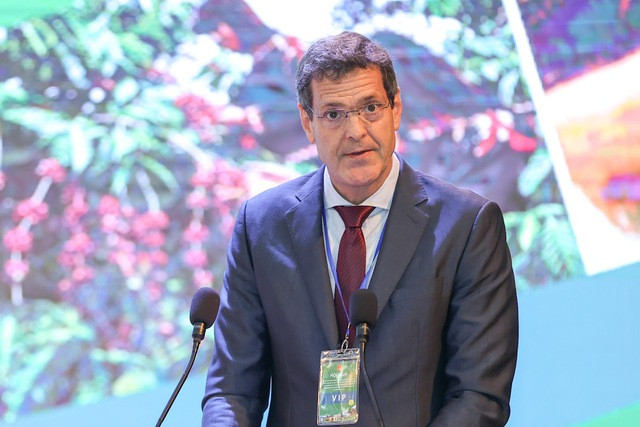
Country Director of the Asian Development Bank (ADB) in Viet Nam Andrew Jeffries attends the conference on Implementation of 2022 Resolution 23-NQ/TW Action Plan for Socioeconomic Development in the Central Highland to 2030 with a Vision to 2045, Lam Dong province, November 20, 2022 - Photo: VGP
Country Director of the ADB in Viet Nam Andrew Jeffries made that above statement while attending the conference on implementation of 2022 Resolution 23-NQ/TW Action Plan for Socioeconomic Development in the Central Highland Region to 2030 with a Vision to 2045 in Lam Dong province, on November 20.
According to the ADB Country Director, the ADB's current country partnership strategy for Viet Nam focuses on fostering inclusive, green, and private sector-led growth and promoting social equality; and helping to build the foundation for achieving Viet Nam's goal of becoming an upper middle income country by 2030.
This is fully aligned with the government's Socio-Economic Development Strategy (SEDS), 2021–2030, he noted.
Andrew Jeffries highlighted that the Central Highland Region has a strategic importance within Viet Nam's economy.
The region is home to nearly 2 million hectares of fertile basalt, making up for 60 percent of the national basalt soil, which is very suitable for cash crops such as coffee, cocoa, pepper, mulberry, and tea.
The Central Highlands is home to four-fifths of the country's coffee production. With the geographical advantages of highlands and numerous waterfalls, hydropower resources of the region have great potential, and the Central Highland Region holds about 8 billion tons of bauxite reserves.
The region also has major advantages for tourism development with Da Lat in Lam Dong Province as one of the greatest tourist attractions of Viet Nam. It is however facing multiple development challenges. Climate change impacts have prolonged and worsened the drought season.
There is a shortage of skilled labor. Infrastructure needs further development, especially the connectivity between the Central Highlands with the other economic centers of Viet Nam.
ADB has been supporting the Central Highlands since its establishment in Viet Nam with a total of 31 projects for improved land connectivity, health, education and vocational training, productive rural infrastructure, and urban development.
One of the most important factors to support the development of the Central Highlands is to develop the connectivity within the region and with other regions of Viet Nam, especially between the Central Highland Region with the Coastal Region.
It is clearly to see how increased connectivity, with reduced travel times and lower transport costs, leads to increased quantities of goods and people traveling along the new or improved routes, increased tourism potential, and creating new opportunities for new small and medium-size enterprises and for job creation.
To help improve connectivity within the region and linkages to border crossings with Cambodia and Laos, ADB approved in December 2016 the Support to Border Areas Development Project to upgrade 263 kilometers of national and provincial roads.
The benefits of improved transport connectivity are further harnessed by promoting ethnic-inclusive and community-based tourism in the region through investments in tourism sites in the five project provinces.
For interregional connectivity, the National Highways No. 26 and No. 29, connecting the costal central provinces of Khanh Hoa and Phu Yen with Dak Lak Province, have a crucial role to facilitate the flows of goods and people between the Central Highland Region and the Coastal Region.
National highway 19 connects with the Le Thanh border gate of Gia Lai province of the Central Highland Region and Binh Dinh province in the Coastal Region.
The ADB continues to stand ready work with the Ministry of Planning and Investment, the Ministry of Finance, the Central Highland provinces and other government agencies to support the Central Highland Region in its ongoing development journey, emphasized Andrew Jeffries.